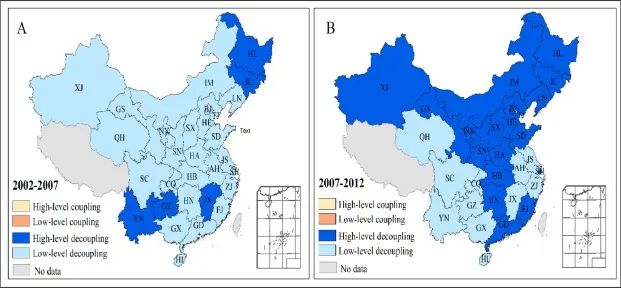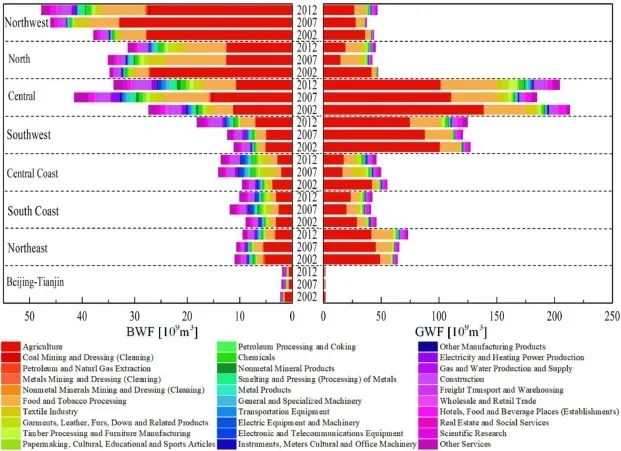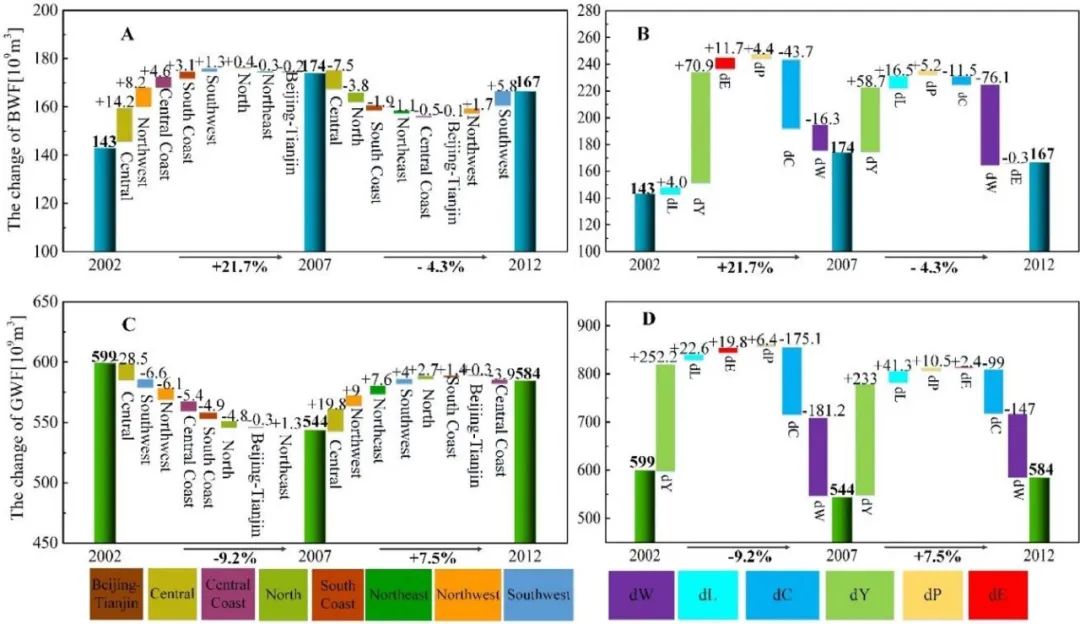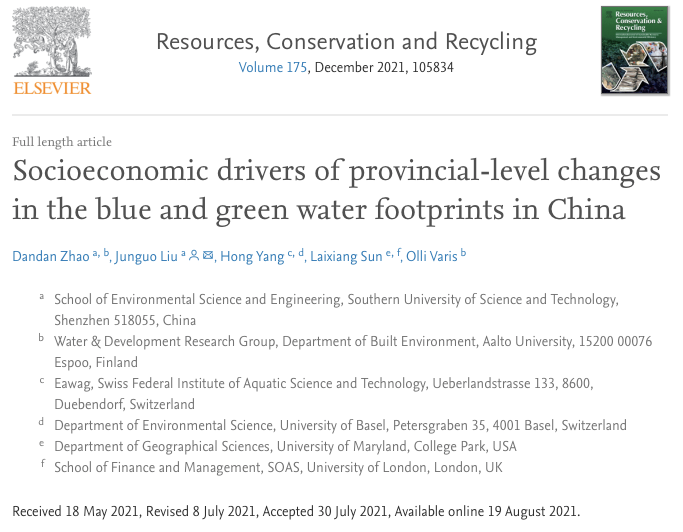原文链接:

图片来源于网络(侵删)
文章导读
水是人类社会所有形式的生命和生产活动不可或缺的资源。淡水包括蓝水和绿水。蓝水是指河流、湖泊、池塘和含水层中的水资源。绿水是指落在陆地上并储存在土壤中或残留在植被表面的降水。据统计,全球用水量已从1900年的500立方千米/年增加到2010年的4436立方千米/年。全球有超过15亿人生活在严重缺水的条件下,水资源短缺已成为威胁人类社会可持续发展的主要因素之一。这在我国等一些快速发展的国家尤为严重。我国人均可用水资源约为2100立方米,仅为全球平均水平的四分之一,是13个缺水最严重的国家之一。人口增长、生活水平提高、消费模式转变和经济活动扩大是我国用水需求上升的主要原因。此外,很大一部分水资源用于生产出口到其他地区的商品和服务,这意味着贸易对当地水资源的影响可能也很大。为了满足未来的水安全需求并找到最有效的水管理策略,必须了解驱动水消耗的时空趋势的社会经济机制以及该消耗在各个经济部门之间的分布。基于此,本研究分析了我国各省蓝水水足迹变化的社会经济驱动因素。
原文摘要
社会经济发展导致蓝水和绿水的消耗量增加,致使我国面临着严重的水资源短缺问题。然而,很少有研究分析蓝水足迹和绿水足迹的相互作用,以及跨省和跨部门水足迹变化的驱动因素。为了填补这一空白,本研究量化了我国各省蓝水足迹和绿水足迹的时空动态,并分析了从2002年至2012年驱动两类水足迹变化的关键因素。本研究通过多区域投入产出和结构分解的方法进行因素分析,同时构建了脱钩指标来量化水和经济的关系以及蓝水绿水之间的替代情况。结果表明,我国的蓝水足迹平均为1610亿立方米/年,约为绿水足迹的三分之一。此外,我国北方缺水省份正朝着经济增长与蓝水消费脱钩的方向发展,同时绿水足迹发挥着越来越重要的作用。水足迹的变化主要受富裕程度(人均最终需求)、技术进步(直接用水强度降低)和消费模式(最终需求构成)变化的影响,而非人口和出口因素。技术进步、消费模式转变和产业结构调整有助于降低水足迹,进一步有助于提高水安全和可持续性。本研究为分析缺水国家的水与经济关系提供了一种新方法。

图1.2002-2012年各省绿水足迹蓝水足迹之间的水经济关系和替代情况

图2.2002-2012年各省蓝水足迹与绿水足迹的关系

图3.2002年、2007年和2012年各行业的水足迹

图4.2002年、2007年和2012年蓝水足迹和绿水足迹的变化

图5.2002-2012年各省蓝水足迹变化驱动因素

图6.2002-2012年各省绿水足迹变化驱动因素
原文信息

Abstract
Socioeconomic developmenthas led to increased consumption of both blue and green water。 Consequently, China is facing seriouswater scarcityissue。 However, few studies have investigated interactions of blue andgreen water footprints, as well as driving forces underlying the changes in water footprints across provinces and sectors。 To fill in this knowledge gap, we quantified the spatial-temporal dynamics of the blue and green water footprint (BWF and GWF, respectively), and analyzed the key factors that drive the provincial-level changes inBWFand GWF from 2002 to 2012。
The analysis is facilitated by the approaches of multi-region input-output analysis and structuraldecomposition analysis, and we developed one decoupling index to quantify the water-economy relation and substitution between green and blue water。 The results show that China's BWF averaged at 161 billionm3/yr, about one-third the size of the GWF。 In addition, water scarce provinces in Northern China were moving towards decoupling between economic growth and blue water consumption, with GWF playing an increasingly important role。
The changes in the WFs were mainly influenced by changes in affluence (final demand per capita), technological improvements (decreased direct water consumption intensity), and consumption pattern (composition of the final demand) rather than changes in the population and export。 Technology improvement, consumption pattern shift and industrial structure adjustment contribute to WF reductions, thus help improve water security andsustainabilityin China。 This study provides a new approach to analyze water-economy relations for water scarce countries。
本期编辑
帅晨阳,密西根大学环境与可持续性学院,博士研究生,研究方向:Data Science Application in Sustainable Development

发表评论